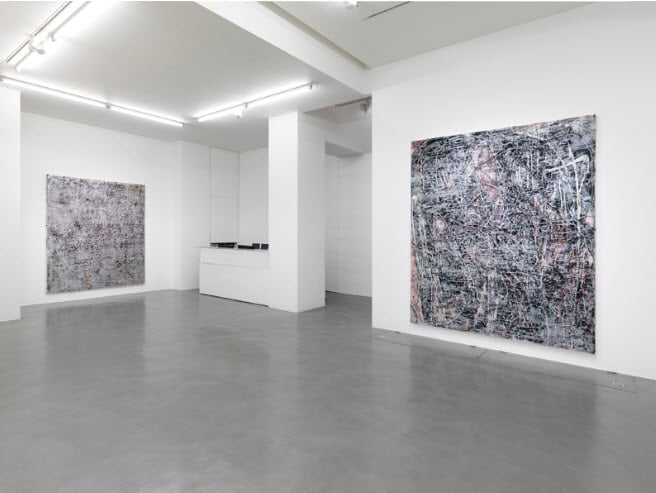People
artnet Asks: Garth Weiser on Masking and Unmasking in Art
His current exhibition is on view at Simon Lee through May 27.

His current exhibition is on view at Simon Lee through May 27.

Artnet Galleries Team

What defines Garth Weiser’s multilayered paintings is their inherent mystery. Images “flicker in and out of focus like analogue TV static,” explains his latest show’s press release. “Ghosts of cartoon-like figures puncture the surfaces, shape-shifting as the eye is teased through dense layers of dots and drips, scumbles and scrapes, peaks and troughs.”
Now on view at Simon Lee in London through May 27, Weiser’s latest body of work represents a six-year process of painterly excavation. Their surfaces need to be seen in person to be believed.
Here, we check in with the artist about his current show, his process, and what we can expect from him next.
What does an average day in the studio look like for you?
I get to the studio around 10 a.m. and leave around 7 p.m. I usually have a few things going at once, as the process is quite involved: There is a lot of masking and removing tape, thick application of oil paint, and spray painting. The last phase of the painting is done in a spray booth with a lot of gear on. Half of the process is blind, in a way, as the painting is masked and then unmasked.

Garth Weiser, installation view. Courtesy of Simon Lee.
When did you know you wanted to be an artist?
My mother and father are ceramic artists. I grew up at the Archie Bray Foundation in Helena Montana, which is a ceramic residency program. My father was the director there from 1976 to 1988. It is a place where ceramic artists from all over the world would come to work and lecture. From a young age, I was hanging out in studios and talking to everyone from French porcelain specialists to Thai folk potters. This I’m sure informed my direction in some way. I think I knew I wanted to be an artist for sure when I went to a small charter art high school in Arizona. The oldest teacher was 30. There were a few teachers that had gone to art school in New York City, and they were great. They had us reading Art Forum and there was even a contemporary art issues class. They would talk to us about the early 90s art scene in New York City, and I found it fascinating at that age.
My parents, both being artists and supporting themselves as artists, did not think it was such a crazy idea for me to follow in that direction. I applied to The Cooper Union in 1999 and was accepted, so I moved to New York and started to study there.
What are some things that inspire you?
Ruins, decay, steel road plates in New York City.
Are there any media you want to explore that you haven’t yet?
I am currently working on some tests for sculptures. I am trying to carve forms with spray paint.

Garth Weiser,3 (2017). Courtesy of Simon Lee.
Do you ever experience artist’s block? What do you do to overcome it?
Yes. I tend to take a finished painting that I think works and start working on top of it. This sometimes leads to a new thing. It’s a way of starting with a scaffold that helps you see what you want to get away from or change in your work.
What is the best show you’ve seen in the past year?
Carol Bove at David Zwirner New York.
Do you collect art? Tell us about your collection.
I would not say I collect art but I do trade with other artists occasionally. Most recently with Trevor Paglen and Eric N. Mack.
What has been the highlight of your career so far?
I would say my show at The Contemporary Austin. Working closely with Louis Grachos on the exhibition and catalog was a real honor. Seeing work from the last ten years all together was a bizarre and interesting experience.
What are you working on at the moment?
At the moment I am taking a break. I just finished a show that opened at Simon Lee Gallery in London on April 20 and a mid-career survey of paintings from 2008–2017 that opened April 3 at The Contemporary Austin. The next show will be at Casey Kaplan in New York in November.
If you could have dinner with any three artists, living or dead, who would you choose?
Gerhard Richter, Philip Guston, and Andy Kaufman.

Garth Weiser, installation view. Courtesy of Simon Lee.
The artnet Gallery Network is a community of the world’s leading galleries offering artworks by today’s most collected artists. Learn more about becoming a member here, or explore our member galleries here.